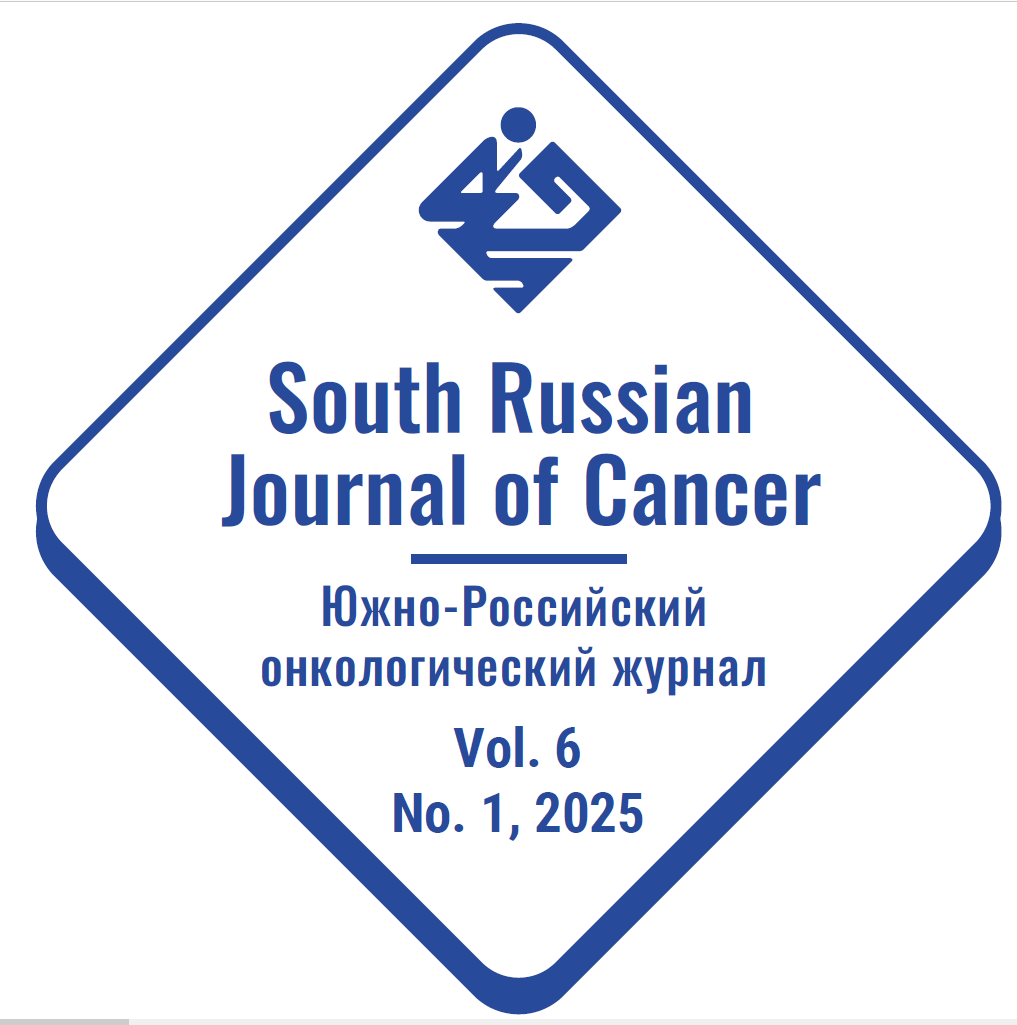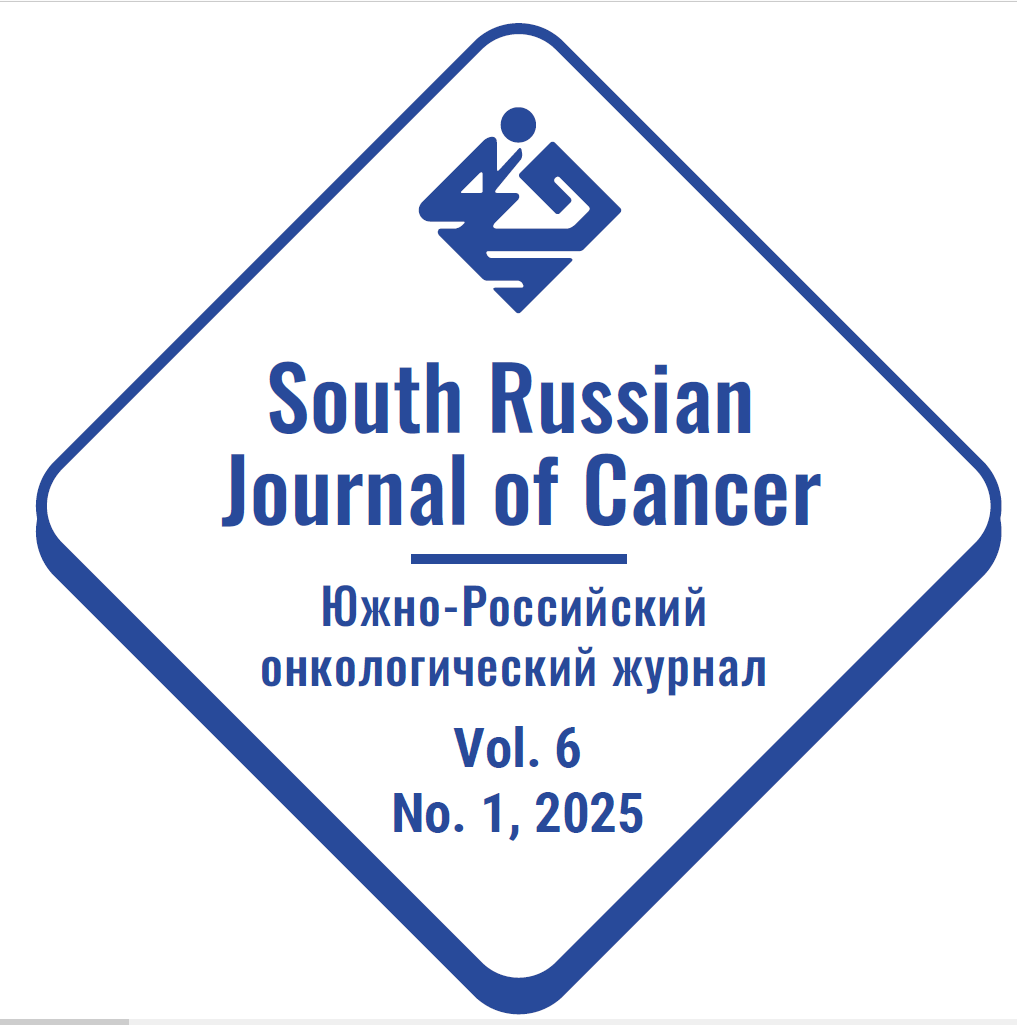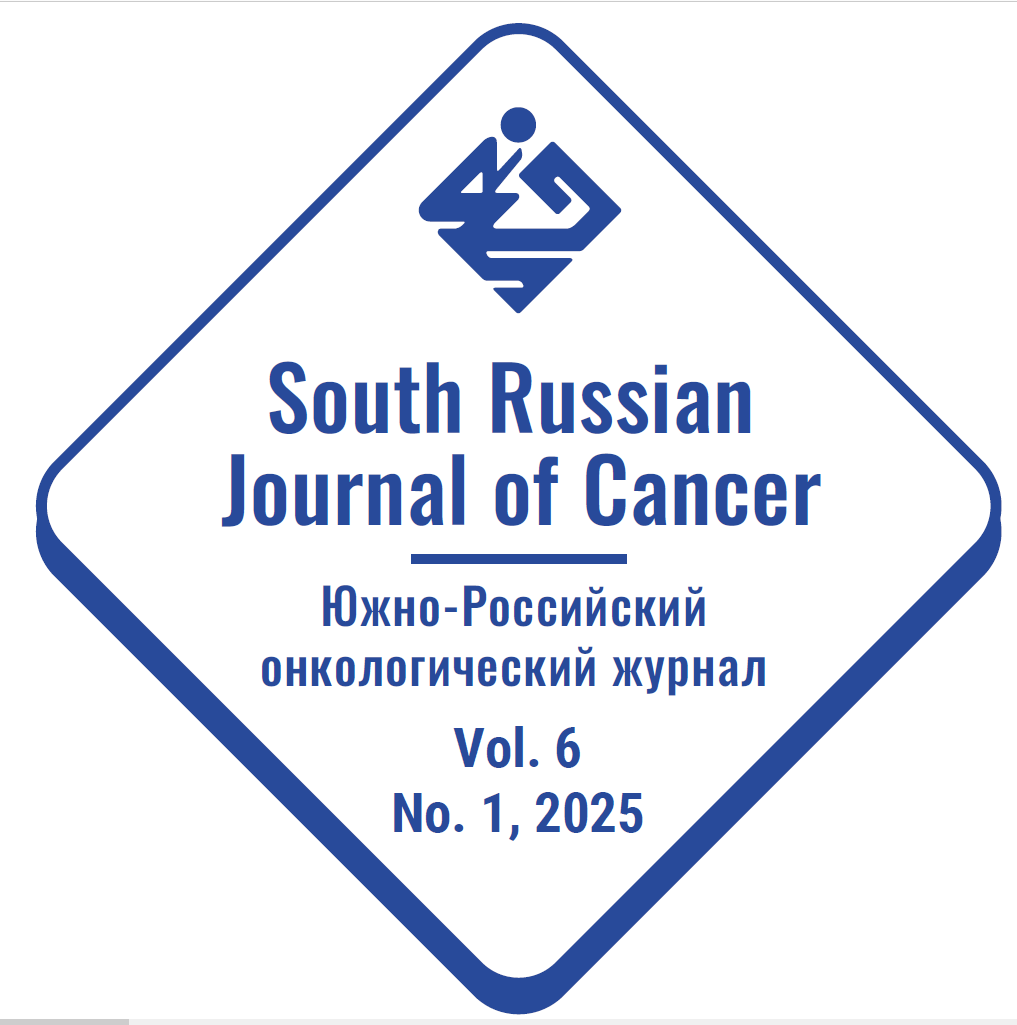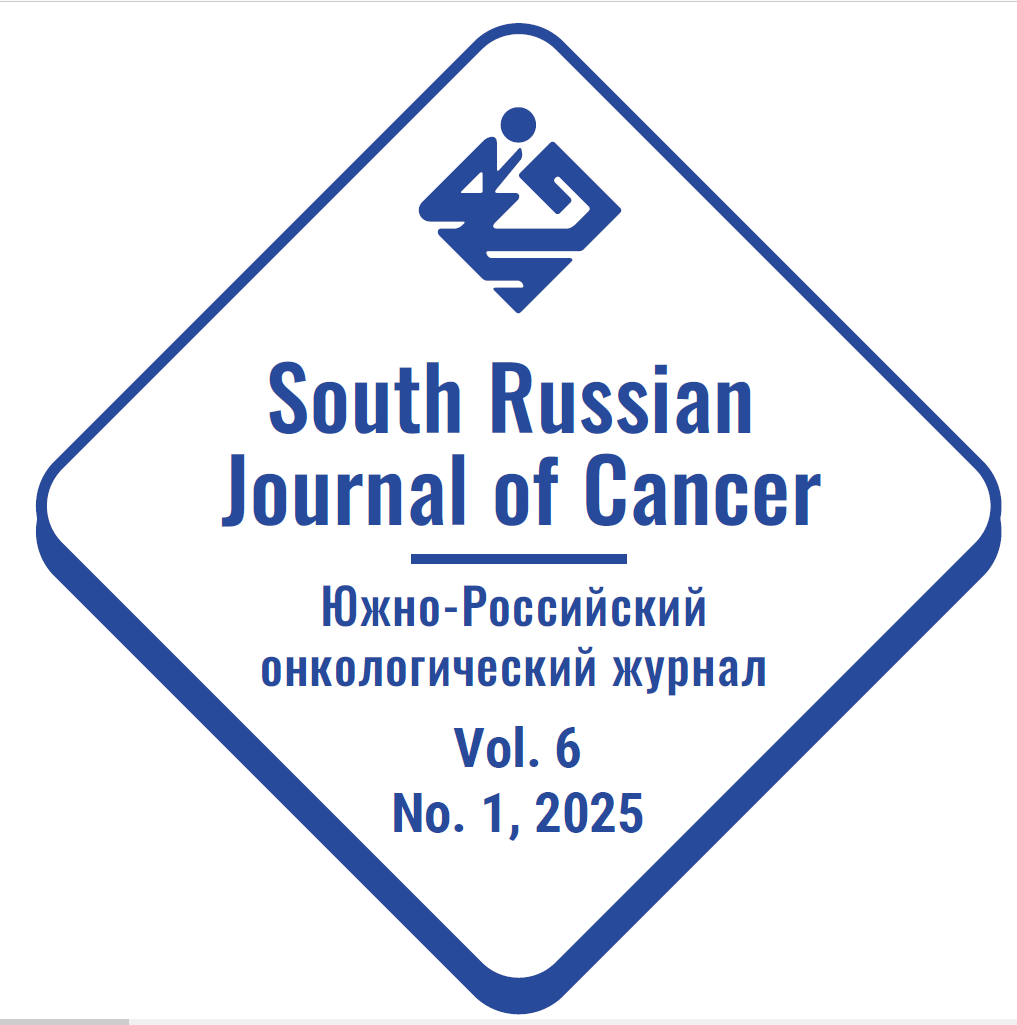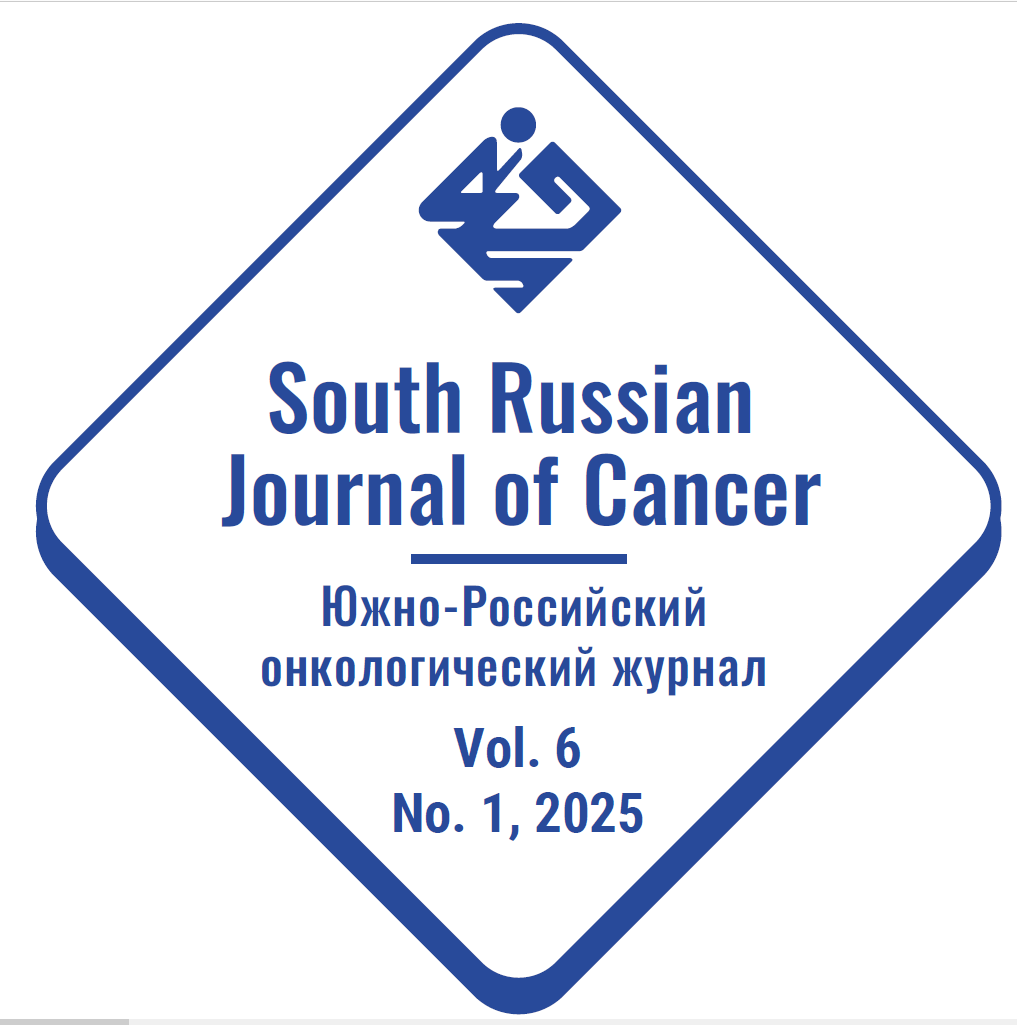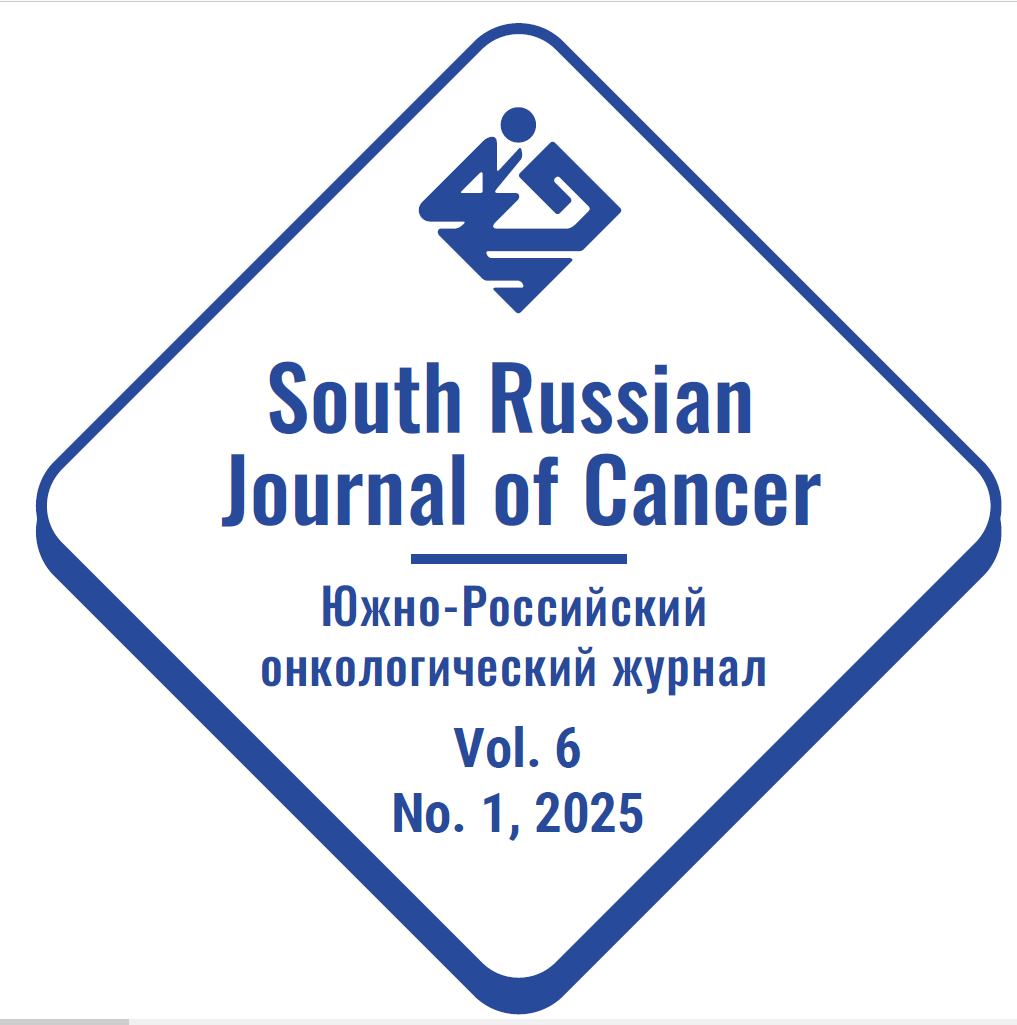Published: 03/17/2025
ORIGINAL ARTICLES
Purpose of the study. Analysis of the frequency of detection of HBsAg-negative hepatitis B serological and molecular biological markers in cancer patients.
Materials and methods. The blood serum samples of patients hospitalized at the National Medical Research Centre for Oncology in 2016–2023 were studied. 41,523 samples were tested for HBsAg, 2,035 for anti-HBcore, of which 958 were tested simultaneously for both markers using the enzyme-linked immunosorbent assay (ELISA) or chemiluminescent immunoassay (CLIA). 1,380 samples were tested for the presence of hepatitis B virus (HBV) DNA in blood plasma using real time polymerase chain reaction (qPCR).
Results. The HBsAg prevalence in cancer patients accounted for 2.5 % (1051/41523), 23.7 % (483/2035) for anti-HBcore. Simultaneous examination for HBsAg and anti-HBcore revealed various combinations of markers. Among HBV-positive variants, the most common was the combination anti-HBcore+HBsAg-. The average number of such patients was 20.6 % (197/958). The simultaneous presence of both markers was noted in 4.6 % of patients (44/958). There were no isolated HBsAg detection cases. The total number of HBV+ individuals was 25.2 % (241/958). 81.7 % out of these (197/241) were HBsAg-negative.
219 samples with the HBV DNA presence in the blood plasma were identified. 19 of these were examined simultaneously for HBsAg, anti-HBcore. The majority (78.9 %) had all three markers. 21.1 % were HBsAg-negative but DNA-positive (latent form of infection), 15.8 % of which were anti-HBcore-positive, and 5.3 % did not have a single serological marker.
Conclusion. The detection of anti-HBcore in the absence of HBsAg can indicate the presence of occult forms of hepatitis B, which under conditions of drug immunosuppression can be reactivated. The identified significant percentage of cancer patients with occult hepatitis B variants highlights the necessity to expand the number of diagnostic markers for screening. Additional testing for anti-HBcore can significantly increase the likelihood of detecting HBV during prehospital testing.
Purpose of the study. To assess the impact of preservation of the duodenal passage on the quality of life (QOL) after total gastrectomy (TGE) in patients with gastric cancer (GC).
Patients and methods. The study included 55 patients with GC who underwent TGE: group I (n = 29) included patients with preservation of the duodenal passage (PDP) using the double tract reconstruction method; Group II (n = 26) included those with standard Roux-en-Y reconstruction. QOL was assessed using the EORTC QLQ-C30 questionnaire with the QLQ-STO22 module for GC patients.
Results. Changes in QOL in patients 3 months after TGE were expressed in a statistically significant decrease in scores of all functional scales (QL, PF, RF, EF, CF and SF), and an increase in the scores of symptom scales (FA, NV, PA, DY, SL, AL, CO, DI, FI), to the same extent for both groups. After 6 months, an increase in the scores of functional scales was noted; statistically significant differences between the groups were identified on the QL, RF, CF and SF scales in favor of the group with PDP. In the group with PDP, a more significant decrease in the level of most symptomatic scales was also noted. After 12 months, a statistically significant advantage remained on functional and symptomatic scales for patients in the group with PDP. Assessment of QOL using the scales of the QLQ-STO22 module showed similar trends: after a sharp increase in symptom values at 3 months after surgery, equally pronounced in both groups, there was a decrease at 6 months, more pronounced in the group with PDP. At 12 months postoperatively, the overall trend towards an advantage in the PDP group continued.
Conclusion. The dynamics of QOL recovery in patients with GC after surgical treatment depends on the status of the duodenal passage: in the group of patients with PDP, faster positive dynamics are observed on all scales of functioning and symptoms than in patients without duodenal passage. Preservation of duodenal passage during surgical treatment of GC has a positive effect on the dynamics of recovery of the QOL of patients with GC, providing a positive contribution to improving the results of antitumor treatment.
Purpose of the study. To study local immunity and cytokine levels in colon cancer patients with subcompensated intestinal obstruction.
Patients and methods. In 60 patients with locally advanced left-side colon carcinoma (30 with and 30 without bowel obstruction) during the surgery samples of tumor, peritumoral area and resection line tissue were obtained. After disintegration of tissue samples Т-, В-, NK-lymphocytes` subsets (CD3+, CD4+, CD8+, CD4+CD25+CD127dim, CD19+, CD16+CD56+) were studied by flow cytometry and inflammatory cytokines` content (TNF-α, IL-1α, IL-6, IL-8) via ELISA test.
Results. Higher levels of interleukins were shown in the tumors of patients in both groups compared to the tumor-free tissue samples. In the presence of subcompensated intestinal obstruction, local levels of proinflammatory cytokines were higher than in patients who did not have it: IL-6 and IL-1a in all tissues studied, IL-8 in tumor and peritumoral zone samples; TNF-α – in the tumor and the resection line. In the absence of intestinal obstruction in the tumor tissue, compared with non-tumor samples, the content of T-lymphocytes was increased due to CD4+ and CD8+, and Tregs levels were lower. These differences were leveled in the presence of intestinal obstruction, i.e. accumulation of T-lymphocytes in the tumor, providing adaptive immunity, was not observed in such patients. Their lower levels of CD8+ T cells and higher levels of Tregs in the tissue of the resection line form a low cytotoxic potential of the tissue remaining after surgery.
Conclusions. The presence of subcompensated intestinal obstruction in patients with colon cancer leads to a number of quantitative changes in local immunity factors compared with patients in whom it was not detected or was compensated. Among these changes, a particularly unfavorable content of pro-inflammatory cytokines, in particular IL-6, in the tissue of the resection line, along with a lower number of CD8+ T lymphocytes and a higher number of Tregs, which suggests a decrease in antiproliferative potential not only in the tumor, but also in non-tumor tissues.
Purpose of the study. To investigate the effectiveness of a new contrast agent based on LaF3:Ce(5 %)Tb(15 %) nanoparticles on a hepatocellular carcinoma orthotopic model.
Materials and methods. The experiment was performed on female BALB/c Nude mice. The subcutaneous model was created by injecting Hep G2 tumor cell culture into the right side of the animals. The orthotopic models were obtained by implanting a fragment of a subcutaneous Hep G2 xenograft into the left lobe of the liver of mice. Colloidal water solutions of LaF3:Ce(5 %)Tb(15 %) nanoparticles were prepared by dispersing the nanoparticle powder in bidistilled water using an ultrasonic tube for 30 minutes. Two samples with different nanoparticle sizes (13 and 60 nm) were administered to mice intravenously in a volume of 200 μl at a concentration of 40 mg/ml. The assessment of changes in radiopacity of the internal organs of animals was carried out at different points in time (before nanoparticle injection, at 5 min, 30 min, 1 h, 2 h, 4 h, 24 h, 48 h, and 7 days after inlection) using microcomputer tomography on a Quantum GX2 device. On the 7th day of the experiment, animals were euthanized by dislocation of the cervical vertebrae, organs (liver and spleen) were collected and fixed in a 10 % solution of neutral formalin. Sections for histological examination and their staining were made according to the standard method.
Results. Microcomputer tomography (micro-CT) results indicated accumulation of both contrast samples in the spleen and healthy liver tissue within 5 minutes after intravenous injection, maintaining X-ray contrast for the 7-days. However, no specific accumulation of nanoparticles in the tumor was observed. Histological analysis revealed minimal impact on the liver structure and cells, with a more pronounced effect in the spleen.
Conclusion. These findings suggest that LaF3:Ce(5 %)Tb(15 %) metal nanoparticles can be used in in vivo experiments for liver and spleen visualization after further investigation of their long-term effects.
Purpose of the study. Was to identify additional prognostic factors in patients with renal cell cancer metastases to the liver influencing survival rates.
Patients and methods. In patients with renal cell cancer (RCC) metastases to the liver, a search for new prognostic factors affecting survival rates is needed. The retrospective analysis of data of 141 patients with liver metastases of RCC treated at the Moscow City Oncological Hospital No. 62 in Moscow and the City Clinical Oncological Dispensary (St. Petersburg) from 2006 to 2022 was carried out. Men prevailed (66.7 %), age 60–74 years in 51.1 %, low-differentiated tumors (56,0 %) and multiple metastases (83.7 %) were detected more often. The study investigated clinical and morphological prognostic factors influencing survival rates in patients with liver metastases of RCC. Statistical analysis was performed using Statistica 10.0 software packages (StatSoft, USA) by constructing Kaplan-Meier curves and survival tables, building a mathematical model of survival.
Results. The 3- and 5-year OS in patients with liver metastases of RCC (n = 141) was 42.4 % and 23.7 %, respectively, with a median OS of 22 months.
In a single-factor analysis in patients with renal cancer metastases to the liver, it was found that ECOG status (p < 0.001), histological subtype (p = 0.01) had a negative impact on survival rates, Fuhrman tumor differentiation (p < 0.001), type (p < 0.001) and number of metastases (p = 0.024), metastases to lymph nodes (p = 0.006), IMDC prognosis (p < 0.001), nephrectomy (p < 0.001) and metastasectomy (p = 0.0006).
In multivariate analysis, ECOG status [HR = 10.09 (95 % CI = 1.31–77], histological subtype [HR = 3,45 (95 % CI = 1.77–6.71], lymph node metastasis [HR = 1.93 (95 % CI = 1.21–3.07], hemoglobin level [HR = 2.44 (95 % CI=1.39–4.29], and undergoing nephrectomy [HR = 2.10 (95 % CI = 1.16–3.79] were additional predictors affecting OS rates in patients with liver metastases of RCC.
Conclusion. In our study, ECOG status, histological subtype, lymph node metastasis, hemoglobin level and nephrectomy were additional independent prognostic factors affecting AE rates in patients with RCC liver metastases. Further studies are needed to identify additional prognostic factors in patients with RCC liver metastases to improve the efficacy of personalized treatment.
Purpose of the study. To evaluate the features of free radical oxidation (FRO) and the principal enzymatic and non-enzymatic links of antioxidant defense in proliferating tissues of benign myoma and malignant endometrioid adenocarcinoma (EA) with varying degrees of differentiation.
Patients and methods. Patients who received surgical treatment for EA (n = 42) and uterine myoma (n = 14) were examined. Patients with stage Ia (n = 26) and stage Ib (n = 16) of disease were selected. 16 patients had highly differentiated (G1) EA, 12 had moderately differentiated (G2) EA, and 14 had low-differentiated (G3) EA. The activity of superoxide dismutase (SOD), catalase, glutathione peroxidase (GPx), glutathione transferase (GST), reduced glutathione (GSH), vitamins A and E, lipid peroxidation products diene conjugates (DC) and malondialdehyde (MDA) were determined colorimetrically in the tissues of EA, myoma and intact uterus.
Results. Compared with the level in intact tissue, SOD decreased by 3.2 times and GST increased by 2.7 times in myoma (p < 0.01). Similar changes were noted for EA G1 – on average by 5.3 times (p < 0.01) and also DC increased by 2.2 times (p < 0.05). In EA G2 tissue, SOD and GPx activities were lower than in the intact tissue, by 5.7 and 4.5 times, respectively (p < 0.05), and lower GST, GPx and GSH than in the EA G1, by 4.9, 8.9 and 1.6 times, respectively (p < 0.05 – p < 0.01). In EA G3 tissue, there was an increase in GSH, GPx and GST from 1.5 to 7.1 times (p < 0.05 – p < 0.01) and lipid peroxidation products by an average of 2.5 times (p < 0.05), as well as a decrease in vitamins A and E by 2.9 and 4.6 times, respectively (p < 0.05) compared with the intact tissue. The tissue of the EA G2 had a minimal level of activity of the GSH-dependent system.
Conclusion. The results reflect the differences in the mechanisms of proliferation regulation by FRO in myomas and in the EA tissue with changes in its differentiation. Knowledge of the characteristics of individual links in the regulation of FRO can play a certain role in the use of antioxidant therapy for benign or malignant tumors of the uterus.



